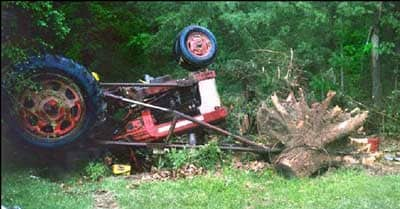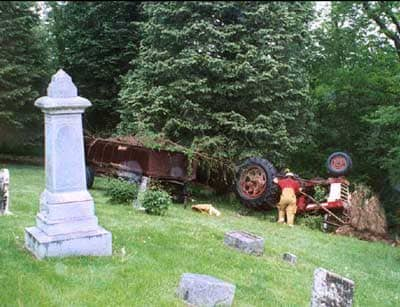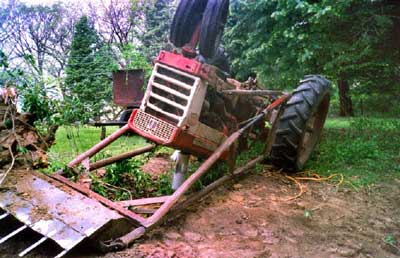Mechanic Dies When Tractor Overturns While Removing Tree Stump in Cemetery
Iowa Case Report: 04IA011
Report Date: June 1 2005
Summary
During the spring of 2004, a 36- year-old mechanic died in a tractor overturn. He was working alone in a cemetery picking up tree trimmings and removing a tree stump. He was using a narrow front- axle (tricycle-type) farm tractor with a front-end loader. The loader was an older model with hydraulically-extendable lower links/lift arms to raise the loader bucket and its load (Photo 1).

|
|
Photo 1 – Side view of the overturned tractor showing the raised front-end loader with the stump secured by a log chain.
|
He had been picking up tree limbs, removing brush piles, and working to extract a large tree stump in an area of the cemetery with sloping terrain. He used a chain saw to cut through the roots of the previously felled tree so he could hoist the old stump from the ground and place it into a nearby wagon, already partially filled with tree branches and trimmings.
The tractor was aimed at an angle forward and downward across the slope, tilting to the left as he attempted to lift the heavy tree stump by raising the front-end loader. The stump was secured to the loader by a log chain around it and the loader bucket. As the loader bucket raised well above the height of the hood of the tractor, the tractor tipped onto its left side and continued to roll onto its top, stopping upside down on top of the operator. The victim was found by another worker who came to the cemetery to mow grass later in the day.
The victim had been crushed between the ground and the steering wheel of the tractor and was pronounced dead at the scene. Because the loader lift arms, and therefore the loader bucket, were raised high the tractor was protected from damage in the overturn. Although there were other tractors reasonably available for the victim to use, none of them were equipped with a loader. The victim had also been drinking alcohol and this likely influenced his assessment of the equipment, loadings, terrain, and overall risk of an overturn.
RECOMMENDATIONS:
- Tractors suitable for the task, properly equipped with a rollover protective structure (ROPS) and seat belt, configured and ballasted appropriately, should be used with a capable, properly-installed front-end loader recommended for the tractor.
- Operators should be educated and trained to recognize and assess the risk of an overturn and the factors that contribute to an overturn.
- Workers should not operate tractors while under the influence of alcohol or when taking medications for which doctors advise against the operation of machinery.
Introduction
During the spring of 2004, a 36-year-old male part-time mechanic was killed in a tractor overturn. Iowa FACE personnel were alerted to this incident by a local newspaper article and began an investigation. Information was gathered from the County Sheriff, the State Medical Examiner, and the Clerk of the local township responsible for maintaining the cemetery (Photo 2).
 |
|
Photo 2 – Overview of the cemetery showing the wagon load of branches and the degree of slope in the area.
|
The Township Clerk, who owns a small farm near the cemetery, would volunteer his tractors and other equipment needed to perform work for the township. This clerk/farmer had hired the victim to perform odd jobs in the past and was aware of his skills as well as his inability to perform strenuous work for more than brief periods. The victim had experience with equipment on the farm and was considered a safe and conscientious worker.
The township did not have permanent employees, but did have a budget to pay for occasional work needed to properly maintain the cemetery. Although safety training may have been part of his previous fulltime employment, no safety training program or written policies were in place at the farm where the victim occasionally worked or within the small, rural township.
Investigation
The victim had performed various jobs for the farmer/Clerk over the past four years and was known to be a good worker. He was a skilled mechanic, worked on small engines, enjoyed working with tractors, and performed farm field work. The Clerk had in previous conversation mentioned to the
victim that trees needed trimming and a stump needed to be removed at the cemetery. There was
an understanding between these two men that the victim could use the equipment and tools
necessary from the farm, including the tractor of his choice, to do this work.
The victim was undergoing treatment for a chronic medical condition that prevented him from working full-time and was on medication (Diazepam) that made him feel tired most of the time to the degree he could not fulfill the requirements of full-time or regular part-time job. He performed occasional mechanical work for others, often doing it for free.
On the day of this incident, the victim was transported to the farm by his wife to start work at about 8 o’clock in the morning. A hydraulic hose on the wagon he planned to use to haul brush needed to be replaced and he exercised his standing permission to purchase repair parts as necessary. He drove one of the farmer’s larger tractors into town before noon to get parts. He was seen after lunchtime driving a similar but smaller tractor pulling the wagon full of tree branches away from the cemetery. Subsequently, upon his return to the cemetery, he started or resumed work on the tree stump, using a chain saw to cut its roots.
Later in the afternoon, another laborer from the nearby farm loaded a lawn tractor and drove to the cemetery to mow grass. While making his first pass around the area, he noticed the victim’s tractor upside down at the base of a short incline. He found the victim unresponsive, crushed between the steering wheel and ground and immediately called for help. When rescue crews arrived, it was determined the victim was dead at the scene.
Photographs confirm the tractor had its front-end loader raised high (Photo 3) with the large stump reportedly tethered by a length of log chain secured around its bucket. The victim was apparently attempting to carry the stump and proceed to load it into the wagon nearby when the overturn occurred. The tractor-loader combination was aimed forward downhill in an area sloping downhill and to the left ahead of the tractor. Rescue workers found a bag containing several cans of beer, and postmortem tests results documented the victim’s blood alcohol content (BAC) at 0.11%. This likely influenced his assessment of the overturn risk, including the equipment, operating, loading, and terrain factors contributing to it.
 |
|
Photo 3 – Front view of the tractor, with the wagon uphill in the background, showing the front loader was raised prior to the overturn.
|
Cause of Death
The official cause of death from the Medical Examiner’s report was “asphyxia due to crushing chest injury due to tractor roll-over”.
Recommendations/Discussion
Recommendation #1 – Tractors suitable for the task, properly equipped with a rollover protective structure (ROPS) and seat belt, configured and ballasted appropriately, should be used with a capable, properly-installed front-end loader recommended for the tractor.
Discussion:All tractors with front-end loaders should be equipped with a roll-over protective structure (ROPS) and seatbelt to minimize the potential for injury in the event of an overturn. Front End loaders should be installed only on tractors that have a wide front axle, not on those with narrow (tricycle-type) front axle, with both front- and rear-wheels of the tractor spaced as widely as possible. The tractor-loader-load combination should be properly ballasted with weight on the rear axle or carried on rear hitch area of the tractor.
Recommendation #2 – Operators should be educated and trained to recognize and assess the risk of an overturn and the factors that contribute to an overturn.
Discussion: Operators should be familiar with safety messages in equipment operator manuals, safety signs, and all safe operating practices. This includes understanding factors that contribute to a tractor-with-loader overturn. Changes in the tractor’s configuration, attachments, ballast, loading, and orientation relative to a slope change the overall stability of the combination in use.
The center of gravity for a two-wheel drive tractor is typically forward of the operator’s feet, ahead and above the rear axle of the tractor. The installation of a loader causes a forward shift in the center of gravity for the tractor-loader combination, and the center of gravity moves upward as the loader is raised. Placing a load in the bucket or lifting a load tethered to the bucket further shifts the tractor-loader combination’s center of gravity forward and potentially upward. As the center of gravity moves forward or upward, the tractor-loader combination becomes less stable because tractors with narrow front axles have a base of stability that is narrower at the front.
The precise positioning of the log chain around the bucket and the stump, as well as the resultant path of the chain between them, could not be determined after the overturn. To the extent that the loader was lifting upward on a stubborn load offset to the left, or the stump was swinging left from the bucket, these factors would contribute to the potential for the overturn.
Recommendation #3 – Workers should not operate tractors while under the influence of alcohol or when taking medications for which doctors advise against the operation of machinery.
Discussion: The victim in this incident was under the influence of alcohol at the time the tractor overturned. He tested 0.11% BAC postmortem when 0.10% (0.08% in some states) is the legal limit for driving a motor vehicle. Alcohol affects judgment and risk perception. It can impair a machinery operator’s ability to perform tasks with the care, precision, and coordination required. In addition, this victim was reportedly taking medication which alone or in combination with alcohol could have adversely influenced his ability to perform the task safely.
References
- ASAE Standards. 2004. S355.3: Safety practices for agricultural front-end loaders. St. Joseph, Mich.: ASAE.
- Bean, T. L. Safety with front end loaders.external icon West Virginia University Extension Service. Available at: http://www.nasdonline.org/document/894/d000728/safety-with-front-end-loaders.html . Accessed 24 May 2005.
- Cyr, D. L. and S. B. Johnson. Front end loader safety.external icon University of Maine Cooperative Extension. Available at: http://www.nasdonline.org/document/1125/d000914/front-end-loader-safety.html . Accessed 24 May 2005.
- Deere & Company. 1983. Materials Handling Equipment. In Agricultural Safety – Fundamentals of Machine Operation, 284-286. Moline, IL.
- HOSTA Task Sheet 4.12 Tractor stability. Hazardous Occupations Safety Training in Agriculture.pdf iconexternal icon Available at http://www.sdstate.edu/abe/extension/hosta/task-sheets/upload/4-12-Tractor-Stability.pdf. Accessed 19 July 2008. (Link Updated 11/15/2011)
- Murphy, DJ. AvailableTractor Overturn Hazards.external icon Penn State University: University Park, PA. at http://www.nasdonline.org/document/906/d000746/tractor-overturn-hazards.html . Accessed 19 July 2008.
- (The) Ohio State University Extension. Loader Safetyexternal icon – Part of Ohio State University Extension’s Agricultural Tailgate Safety Training Series. Ohio State University Extension. Available at: http://www.nasdonline.org/document/1807/d001752/loader-safety.html . Accessed 24 May 2005.
Iowa FACE Program
Fatality Assessment and Control Evaluation, FACE, is a program of the National Institute for Occupational Safety and Health (NIOSH), which is part of the Centers for Disease Control and Prevention of the U.S. Department of Health and Human Services. Nationally, the FACE program identifies traumatic deaths at work, conducts in-depth studies of select work deaths, makes recommendations for prevention, and publishes reports and alerts. The goal is to prevent occupational fatalities across the nation.
The NIOSH head office in Morgantown, West Virginia, carries out an intramural FACE case surveillance and evaluation program and also funds state-based programs in several cooperating states. In Iowa, The University of Iowa through its Injury Prevention Research Center works in conjunction with the Iowa Department of Public Health and its Office of the State Medical Examiner to conduct the Iowa FACE program.
Nationally, NIOSH combines its internal information with that from cooperating states to provide information in a variety of forms which is disseminated widely among the industries involved. NIOSH publications are available on the web at https://www.cdc.gov/NIOSH/FACE/.
Iowa FACE also publishes its case studies, issues precautionary messages, and prepares articles for trade and professional publication. In addition to postings on the national NIOSH website, this information is posted on the Iowa FACE site, http://www.public-health.uiowa.edu/FACE/external icon. Copies of FACE case studies and other publications are available by contacting Iowa FACE, too.
The Iowa FACE team consists of the following specialists from the University of Iowa: Craig Zwerling, MD, PhD, MPH, Principal Investigator; John Lundell, MA, Co-Investigator; Murray Madsen, MBA, Chief Trauma Investigator; and Co-Investigator/specialists Risto Rautiainen, PhD, and Wayne Sanderson, PhD, CIH. Additional expertise from the Iowa Department of Public Health includes Rita Gergely, Principal Investigator, and John Kraemer, PA, from the Office of the State Medical Examiner.
To contact Iowa State FACE program personnel regarding State-based FACE reports, please use information listed on the Contact Sheet on the NIOSH FACE web site Please contact In-house FACE program personnel regarding In-house FACE reports and to gain assistance when State-FACE program personnel cannot be reached.

